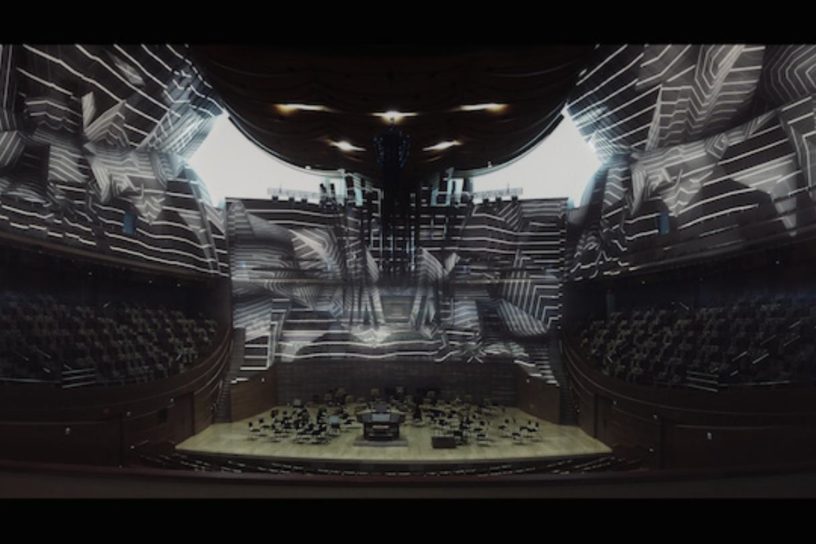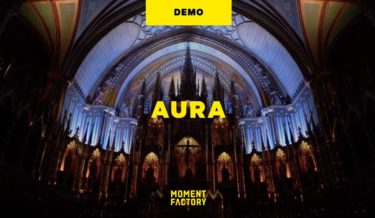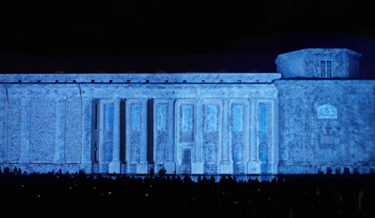Images courtesy of the artist
Weaving a virtual tapestry, artist Refik Anadol transformed an LA Philharmonic performance with an unprecedented audiovisual display at the Frank Gehry-designed Walt Disney Concert Hall for an experiment in reinvigorating the concert format with architecture and light.
“I’m always dreaming about spaces and buildings,” says Anadol, who uses giant facades as canvases. With light, media, and soundscapes, he has shattered and rebuilt an abandoned tobacco processing plant in Austria, extracted the skeletal insides of the Arc de Triomf in Spain, and embedded a digital garden onto real trees at the Hammer Museum. These works are more than stunning video montages or light shows—they are nodes in Anadol’s ongoing exploration into creating immersive, interactive environments, the ways in which our understandings of space are evolving, and how media technologies can shift our conceptualizations of space and time.

Tree of Life, 2014
Anadol first began experimenting with videography and architectural photography as a visual design student at Bilgi University in Istanbul, Turkey. Inspired by the techno-dystopian backdrop of one of his favorite films, Blade Runner, Anadol desired to emphasize the moment of “seeing a picture through urban space, and through architecture” in his own practice. He wondered if media could transform existing architectures and spaces into futuristic post-digital formations, structures, and stories.
For his first audiovisual performance, or “first public intervention,” as he describes it, Anadol manipulated footage of colliding quadrilaterals and digital noise to create Quadrature, an illusion that breaks apart and re-forms the cubic main facade of Santralİstanbul Art and Contemporary Center. Online, the piece went viral.
QUADRATURE from Griduo on Vimeo.

Augmented Structures v.1.0, 2011
From there, Anadol continued testing the boundaries between space, sound, visuals and light. He transformed sound recordings of Istiklal Street into a parametric structure for an “urban experience,” investigated the sculptural quality of visual music by creating algorithmic structures from real-time sound data, built an immersive audiovisual installation centered on the idea of epiphany, and contemplated the human brain as a television studio. “I’m a researcher as much as an artist,” Anadol explains. Fundamentally tied into the study of media archaeology, his hunger for a deeper well of knowledge led him from Turkey to UCLA to pursue his second MFA degree.
When Anadol first arrived in Los Angeles, Gehry’s Walt Disney Concert Hall caught his eye and lodged its image into his mind. For his final design thesis, Ethereal, Anadol envisioned wrapping the curves and contours of the concert hall with a stormy visual media performance that responded to the music being played inside. Because the building was an iconic form that everyone knew, his technological reading had to be more than a light show. Anadol decided to consider the building as its own artificially intelligent entity: “The building knows what’s going on inside itself, and changes according to the mood of the music inside.” Using multiple projectors, a 1/20th scale mockup of the building, custom software, and 7-channel sound, he presented the work as a “perpetual idea,” or case study, for evolving an iconic building with technology.

Ethereal, 2013
At the same time Anadol was tying the threads of his thesis, the LA Philharmonic was researching new ways to transform the traditional concert format into an immersive modern experience. They launched In/Sight, an experimental series that pairs the orchestra with media artists, and selected Anadol as their first collaborator. The challenge was to turn the performance into a transcendent, cinematic experience for the viewer, explains Anadol. “An immersive installation, using the existing geometry of an interior space, allows viewers to make much stronger connections because being inside of a space brings art perception into the story itself,” he adds.

Anadol first began thinking about the story he could tell using a 3D model of the theater’s interior. He and a team of engineers, artists, and designers built custom software on a visual-textual programming platform vvvv. Additional technology would be needed to create the generative visuals that would track data from LA Philharmonic Conductor-Laureate Esa-Pekka Salonen’s body movements. “To create the 21st century’s performing experience, we needed to re-invent most of the behaviors that are working for the conventional performance pipelines,” he says.
Working together with Salonen, Anadol then had to translate the music of Edgard Varèse into what can best be described as “visual epiphanies.” Varèse described his musical composition, Visions of America: Amériques, as a “symbolic of discoveries—new worlds on earth, in the sky, or in the minds of men,” and it was the first piece Varèse composed when he came to New York. At the start of the symphonic work, Anadol creates a sensory experience that encapsulates the moment when Varèse first arrived. Then, as the symphony churns forward, Anadol takes viewers through the tunnels of Varèse’s mind, through visions of the future of Varèse’s art, and ends with an epic final celebration of presence as the visuals intertwine with the information from Salonen’s movements.
In addition to experimenting with light, audio, and performance, Anadol is curious about using other mediums for building alternate realities, including as robotics and digital fabrication technologies. He released Cavity, a series of 3D-printed works and projected works inspired by the formation of geodes. “I wanted to mimic nature by code,” he explains. Surrounded by the ambient “sound” of crystals growing, the two different mediums of this work represented virtual and physical geological states, separate but intertwined.

Cavity, 2014
An earlier work, The Aether Project, was the spark for Anadol’s ongoing interest in robotics and the ways in which robots can convey “emotions.” He and a team of collaborators created an “immersive interactive environment that was created from robotic actuation, formal transformation and real time projection mapping controlled by a sensory input device.” In real time, a Leap Motion controlled system mapped visuals onto an object’s surface as its movements were controlled with robotics. With this experiment, they imagined architecture enhanced with robotics and sensing technologies as a way to create truly “smart” environments, and questioned the relationship between robots and between robots and humans.
THE AETHER PROJECT from Refik Anadol on Vimeo.
All of his many tangential journeys add up to a single conclusion: “Architecture will evolve,” Anadol believes. “And I find myself, as an artist, very responsible in taking up this new territory, to create alternative realities and stories by using technology and design, mutually.” For all of his works—be they large or small, lasting or ephemeral, digital, physical, or both—he hopes viewers will take home a moment that they’ve never felt before.
Click here to learn more about Refik Anadol’s work.
This article was originally published on October 23, 2014.
Related:
The Science Of Sound Gets Visualized In This A/V Experiment
Source Creators
Follow our FB page Lumen




